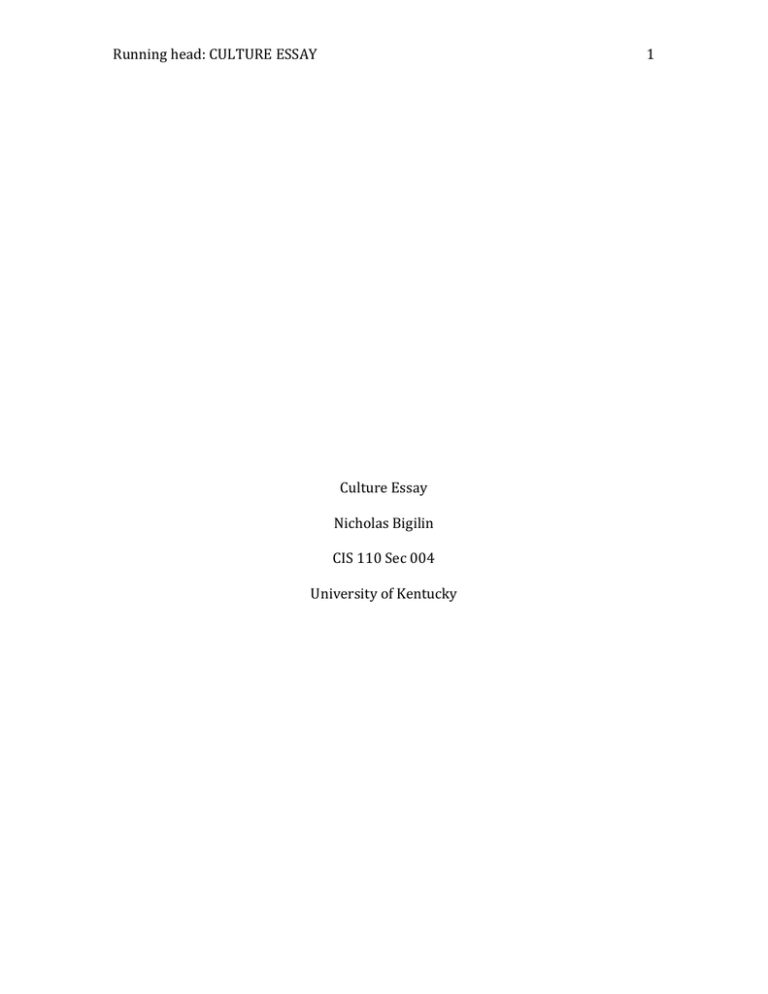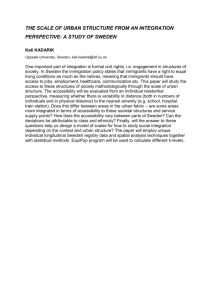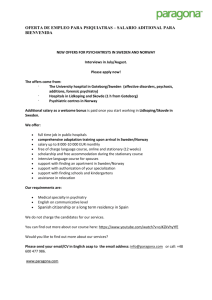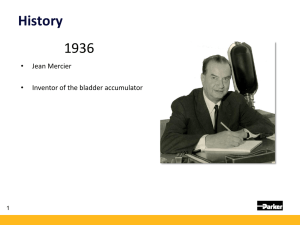File
advertisement

1 Running head: CULTURE ESSAY Culture Essay Nicholas Bigilin CIS 110 Sec 004 University of Kentucky 2 Running head: CULTURE ESSAY Ikea, Meatballs, and incredibly tall people with blonde hair: a store, a food and a stereotype are most likely the first three things that come to mind when a person hears, Sweden. Sweden is a European country located in Scandinavia, in between Norway and Finland. With its rich Nordic History and its extremely modern socioeconomic stance, Sweden has become a model to many of the currently struggling European Countries. Sweden has not been involved in a conflict in nearly two decades and this long period of peace has allowed the country to create a thriving economy and an incredibly high quality of life. Sweden has one of the most liberal governments and populations in the world. It’s liberal views carry into every aspect of society such as religion, economics, and healthcare, and family life. Sweden’s History Throughout the history of Sweden, the country has been perceived by other European nations as place of darkness associated with strange languages, distance, alien cultural behavior, and just plain bad weather (Sweden Historiography 2014). It was a country that is many respects was not taken seriously. Known for it’s fog and perceived secretiveness, Sweden for most of its history was fighting an up hill battle trying to have its ideas and policies seen as legitimate. It is important to understand a nations history before exploring the current state of the country. Sweden has been shaped by its past in many ways, the largest of which is that because for centuries it has not been taken seriously by the southern European countries. This lack of regard by their southern 3 Running head: CULTURE ESSAY neighbors has forced the Swedes to push themselves to do better and create a model nation in political structure, technology, and overall quality of life. The Nobel Prize There is no better example to show Sweden’s transformation from a country that European nations disregarded to a nation of great respect on a global scale, than the Nobel Prize. The Nobel Prize is considered by many to be considered the world’s most prestigious academic award. It has been given to people and organizations every year since 1901 for achievements in physics, chemistry, physiology or medicine, and peace. It was also given for economics in the year 1968 (Sweden 2014). The prize is given in honor of Alfred Nobel. Nobel was a Swedish chemist, physicist and entrepreneur. He is accredited with discovering dynamite. The discovery of dynamite was by far his largest accomplishment but he also had three hundred and thirty five other patents in twenty different countries (Nobel Prize). The recipient of the Nobel Prize is awarded 1.1 million USD. When Nobel signed his final will in 1895 he had no children, so he left a large bulk of his estate, 31 million USD to be exact, to four Swedish institutions. These institutions came together and formed the Nobel foundation. The foundation currently pays the 1.1 million USD prize from its return on investments. The Nobel foundation is currently worth around 474 million USD. For a country that was for so long shown no respect and seen as a land stuck in the stone age it is incredibly ironic that Sweden is now responsible for issuing the most prestigious academic award in the world. Religion Running head: CULTURE ESSAY 4 Religion plays an immense role in most countries throughout the world. It does not matter whether the country is secular or religion dominates the government, it is always present. Sweden is a rare nation in which this is not the case. Only twenty nine percent of Swedes claim to be religious where internationally that number is fifty nine percent (Sweden 2014). Sixty Six percent of Swedes are members of the Church of Sweden, but only eight percent of this group attends religious ceremonies with fluidity (Sweden 2014). The Swedish national website says that the nation is made up of a majority of Atheists, and that nationally they do not see a correlation between religion and happiness. When interviewing Hampus Agerstrom a native of Helsinborg Sweden I asked his if he was religious, and his reply was emphatic “No way bro” (Hampus Agerstrom, personal communication, September 26, 2014). Hampus also went on to tell me that he does believe in God but he does not practice any faith (Hampus Agerstrom, personal communication, September 26, 2014). He also explained to me how it is not a personal choice to not practice religion but more of a family circumstance in that his family never did so he doesn’t, and when I asked him why his reply was vague “My dad is kind of an atheist” (Hampus Agerstrom, personal communication, September 26, 2014). The Church of Sweden itself would technically fall under the Christian denomination because of its belief in Jesus, but this is one of the few similarities it shares with other Christian Churches. The Church of Sweden has taken on a very Liberal view with its beliefs and practices. The Church supports abortion, sex out of wedlock, and same sex marriage, all of which are generally not supported by other religious faiths. Another major difference between the Church of Sweden and other Christian Churches is Running head: CULTURE ESSAY 5 that women can be part of the Clergy. In 1945 the first woman was made a priest in the Church of Sweden, and forty five percent of the young people currently studying to be priests in Sweden are women. Also, a woman currently holds the most prestigious position in the church, her name is Antje Jackelén and she is the Archbishop of Uppsala (Sweden 2014). Religion plays a very minor role in Swedish society and the Church of Sweden has a much different belief system than all other Christian denominations. Economy and Healthcare Two centuries of complete peace has allowed Sweden to form an incredibly stable and thriving economy. Sweden has achieved a high standard of living by living under a split system of loosely interpreted capitalism and extensive welfare benefits (CIA 2014). The CIA’s report on Sweden’s economics states that “ It has a modern distribution system, excellent internal and external communication and a highly skilled labor force” (CIA 2014). The Swedish economy is heavily rooted in foreign trade, and the raw materials that make up many of there exports are timber and iron ore. Prior to the Stock Market Crash in 2008, which effected economies internationally, Sweden was on an economic upswing that was boosted by a return to the purchase of domestic products and a large amount of exporting. The crash in 2008 halted the economic prosperity but has not hurt Sweden as it did the United States and other Western Nations. Sweden’s national website states “Sweden’s present economic and social status was built on the lessons learned from the financial crisis in the early 1990s. Governments pursued reforms and fiscal sustainability became institutionalized. Stable economic policies combine with competitiveness, innovation and an open approach to trade to make Sweden a model for Running head: CULTURE ESSAY 6 economic success” (Sweden 2014). Healthcare in Sweden greatly differs from healthcare in the United States. The responsibility for healthcare in Sweden is shared between three different governing bodies, the central government, county councils and local municipalities. The only role of the central government is to set up guidelines. The majority of healthcare is handled on a local level (Sweden 2014). Healthcare in Sweden is almost completely free, so county councils are responsible to provide quality healthcare for all of its residents and they are also responsible for the dental care of all inhabitants that are under the age of 20 (Sweden 2014). People in Sweden have been living increasingly longer and the countries life expectancy is now at 83 years old. Sweden’s healthcare system seems to be working splendidly but in talking with two native Swedes the system has many drawbacks. When interviewing Stefan Stojkovic, a native of Halmstad Sweden I found that he had some positive remarks but also found many faults in Sweden’s system. He spoke of how it is a great system because “No matter what family’s income is they get medicine”, but this is one of the only positive things taken from the healthcare question (Stefan Stojkovic, Personal Communication, September 25, 2014). One of the major negative things he spoke of was how in Sweden they don’t have as many healthcare facilities as the United States. He was extremely shocked when he came to Lexington that we have three Hospitals within a five-block radius. He said to me “In Sweden bro we have one hospital in major city, and Lexington is small bro” (Stefan Stojkovic, Personal Communication, September 25, 2014). In further research He told me a personal anecdote that perfectly sums up all of the problems in Swedish healthcare. He was playing a soccer game in Central Sweden nowhere near a major city. During the game he Running head: CULTURE ESSAY 7 tore his ACL, and needed to be taken to a hospital extremely quickly. The closest hospital to him was two hours away (Stefan Stojkovic, Personal Communication, September 25, 2014). It is understandable that this problem may occur in America as well especially in the more open states of the Mid-West but it is hard to believe that a person would have to travel two hours to get to the nearest hospital. His story continued and raised another major issue with Swedish healthcare and that issue is the lack of availability of medical technology and specialists. In the United States every hospital has an MRI machine, and CAT scan machine, an X-Ray machine, etc. but in Sweden many hospitals do not according to Stojkovic (Stefan Stojkovic, Personal Communication, September 25, 2014). His anecdote continued “ They did not have machine to look at my knee, so I have to go all the way back to Halmstad so they could look at it” (Stefan Stojkovic, Personal Communication, September 25, 2014). When Stefan finally got a diagnosis it was determined that he needed surgery (Stefan Stojkovic, Personal Communication, September 25, 2014). In the United States when it is determined someone needs ACL surgery from personal experience I know the wait time is around two weeks. Stefan had to wait for five weeks for his surgery because of the lack of specialists in the country (Stefan Stojkovic, Personal Communication, September 25, 2014). He also told me this 5 weeks was a short wait because he was an athlete so he got somewhat preferred treatment (Stefan Stojkovic, personal communication, September 25), 2014 Sweden’s national website states that the average wait time just to see a specialty medical care physician is about 90 days (Sweden 2014). After seeing a specialty care physician the website states that nine out of 10 people are operated on within the next 90 days (Sweden 2014). So it is possible to wait a full three months from the time of injury to receiving an operation. The 8 Running head: CULTURE ESSAY long wait for specialty healthcare is because the entire country only has 61 hospitals that provide specialty care (Sweden 2014). Role of Women As in the case of many countries throughout the world, a major issue in Sweden is gender mainstreaming. Many people have become uncomfortable with the “classic” gender roles that men and women play in society. Examples of classic gender roles would include stereotypes of the woman staying home cooking and cleaning while the male is the sole breadwinner of the family. In twenty first century society this idea has been greatly criticized as woman have fought for equal opportunities in the workplace. In Sweden this is extremely prevalent in urban locations (Gender Mainstreaming 2014). Swedish women are fighting many feminist battles, and they play a very important and influential role in society. Compared to American culture, Scandinavian cultures in general, are known for being more progressive in the area of feminism. We perceive them as being feminine, but many in the country itself feel there is still a gap between the two genders. When interviewing Hampus I also brought up the topic of woman’s rights and he told me “people think women are treated more equally than they are, in Sweden they are trying to get equal rights.” (Hampus Agerstrom, personal communication, September 26th, 2014). He also told me that protests for woman’s rights have been known to become very violent and in one case women stormed a strip club and beat the men inside with baseball bats and sacks full of metal (Hampus Agerstrom, personal communication, September 26th, 2014). Although it is perceived that men and women in 9 Running head: CULTURE ESSAY Sweden are on and even level, it is apparent that there are still strides to be made. A model for many countries around the world Sweden has risen from a country that was seen as a mystical land of fog, darkness and alien culture to a global leader. Sweden is much more than tall blondes, meatballs and a furniture store. It is a country filled with people striving for excellence in politics, economics, healthcare, and equality. Abstract Sweden is a country in Scandinavia that many Americans have false stereotypes or just do not know much about. Sweden has become world leaders in many area’s including the economy. The Swedish economy has held fast and not faltered as many other countries economies have since the global crash in 2008. Sweden is known for its incredibly liberal views. Their liberal way of thinking carries over into all aspects of life. In this paper I will be exploring how Sweden’s liberal outlook impacts it’s dealings with religion, economy healthcare and the role of women in the country. I will also be comparing these areas of Swedish culture to the corresponding areas of American culture. References Alfred Nobel. (n.d.). Retrieved October 1, 14, from http://nobelprize.org Health care in Sweden. (n.d.). Retrieved from https:/sweden.se/society/health-care-in- Running head: CULTURE ESSAY Sweden Sweden Economy. (n.d.). Retrieved from https://www.cia.gov/library/publications/theworld-factbook/geos/sw.html Knoespel, K. J. (2014). Sweden and the Transformation of Northern Historiography. Journal of Northern Studies, 103-119. Retrieved October 1, 2014. Zebracki, Martin (2014). Sex in the City :Gender mainstreaming urban governance in Europe. The case of Sweden and Italy. Fennia 192:1,pp 54-64. ISSN 1798 10






